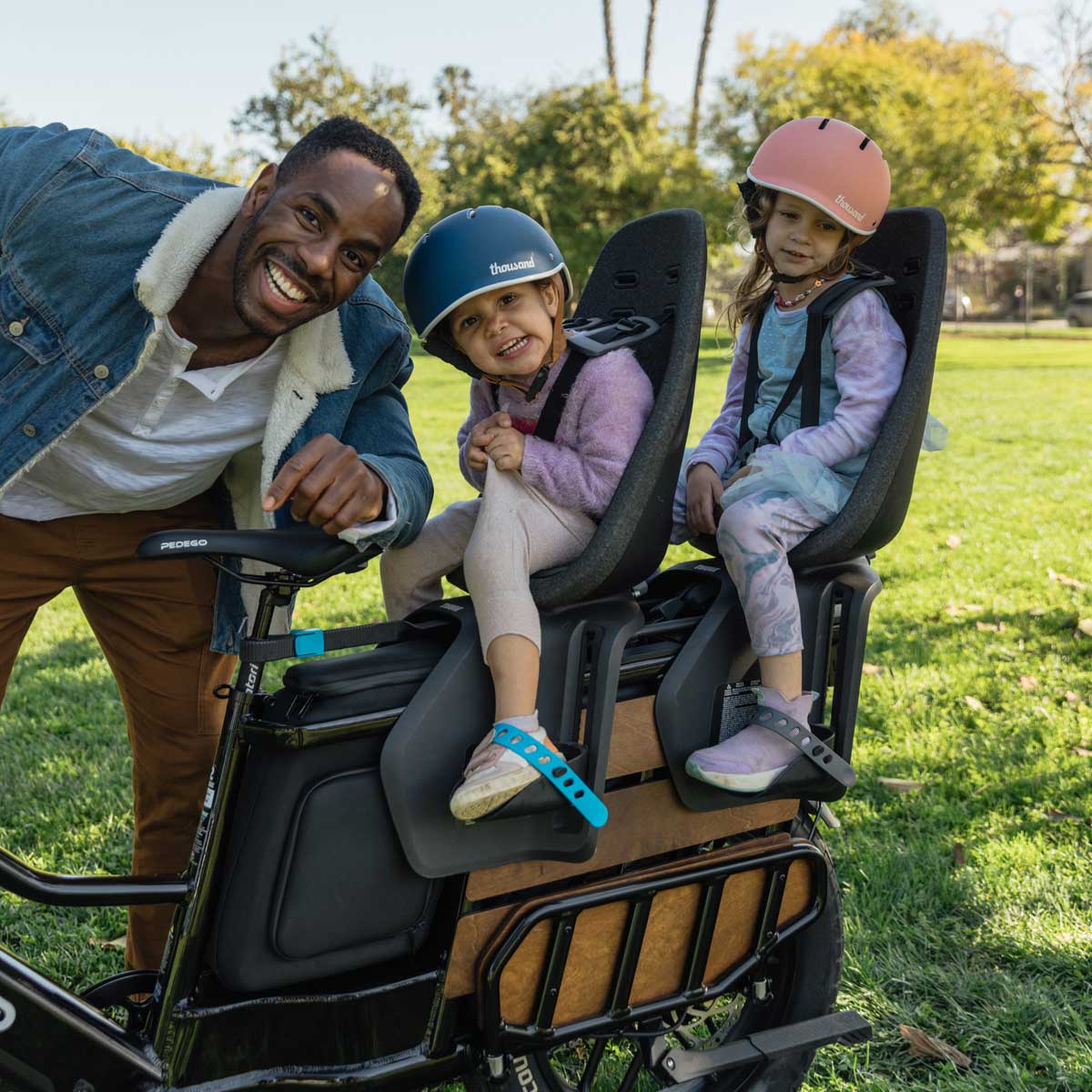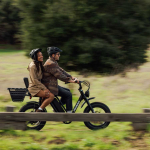How to Safely Cruise with Kids on Your Pedego Ebikes
April 19. 2024
Kids are the most Precious Cargo – How to Safely Cruise with Kids on Your Pedego Ebikes
Transporting your family with your Pedego Cargo or Moto ebikes is the ultimate way to transform how you operate your household. The cost savings, convenience and family connection can’t be beat!
Pedego Canada wants to make sure that as you embark, you are taking every precaution with your most precious cargo – kids. Here are some valuable safety suggestions to consider.
What Are the Rules for Biking with my Baby?
Laws regarding bike riding with children in Canada vary slightly by province and territory. However, here are some general guidelines that can help keep you and your very little one safe wherever you may be cycling. (When in doubt, your pediatrician can give you the best advice for YOUR child.)
When people first think of bike riding with small children, they may question the safety of taking such a small person out into traffic. They’re probably fearing what would happen in event of a car accident. Of course, accidents are bad and to be prevented, but the main reason to wait to ride with them is because their little bodies are still developing. Their brain, skull, neck, spine, and further systems are still maturing.
“Experts” say that at around age one a baby has the neck strength required to ride passenger, wear a helmet and they are less impacted by the jostles and bumps.
A helmet is the law and very important to anyone riding a bike – yet it can be a problem for younger babies. A helmet adds weight to an unstable head and when worn in a reclined position (baby in a trailer), it forces the head into an unnatural forward position for the duration of the ride. A good helmet also fits perfect. How do you get a proper size on a growing head? If you can’t provide the best helmet for your baby, wait to ride with them.
What Are the Carriers Out There?
Any carrier you choose should meet all safety standards. Check manufacturer’s weight and age limits. Install and use according to directions.
- Front/Back Seats – You can attach a seat at the front or back to carry your child. Keep in mind that the weight will be felt quite differently with a passenger up that high. Falls will be from higher as well. For safety, get spoke guards to protect dangling little feet and fingers. You will also need a kickstand to load. Parents often like this carrier because they can hear their child better than if they were lower in a trailer.
- Trailers – A quality bike trailer comes with safety features included in its design such as a roll cage and rotating hitch. They should also have reflector tape and a flag to ensure its well seen. A trailer allows your child to stay protected from the weather, but it can be difficult to keep those lines of communication open. “Snack please?” Never overload your trailer and child with groceries or other cargo especially if it can shift or takes you over your carrier’s weight limit.
- Bakfiets – A bakfiets is a spacious, sturdy cargo box located at the front of the bicycle. This cargo box is often called a Dutch bakfiet and typically made of wood, metal, or other durable materials and is designed to carry various loads including a child.
- Cargo bikes – If designed to carry people, a cargo bike can be an eco-friendly way to passenger bigger kids around town. Learn about Pedego’s Cargo Ebike!
- Riding Solo – Your child is ready to ride on their own between the ages of 4 and 8. Enrolling them in a local bike safety course is ideal!
What Else Can You do to be Safe
- All carriers should have proper straps/harnesses. Use them.
- Choose routes with smooth trails – cobblestone streets, massive potholes and rutted trails do not make for a comfy ride. Suspension on carriers will reduce the effects of bumpy roads.
- Choose routes with less busy traffic or take advantage of bike routes.
- Avoid sudden movements, abrupt stops, and fast descent. This isn’t a roller coaster ride.
- Never carry infants in backpacks or front packs on a bike.
- Mirrors can help you see your child when they are riding behind. Develop hand signal systems with older children.
- Don’t leave your child unattended in the carrier.
Ready to Begin?
First, consider your own cycling ability. Are you a competent rider comfortable to ride with additional weight or balance considerations? Will you be able to balance a new high-centred weight? Can you tow a heavy trailer? Are you an expert at navigating in traffic? Don’t head out into traffic for the first time with your one-year-old in tow. Take a test ride so you know you can do it and your child is feeling comfortable before the first real trip.
Standard rules of safety always apply – allow for lots of space, be seen, and be clear about your intended moves. Maintain your vehicle! Make sure your bike is in good working order with brakes, tires and gears functioning well.
The Dutch Experience
People often point to family cycling culture in The Netherlands as they argue for the safety of biking with their young child in North America. Unfortunately, we can’t compare. Cycling with kids has been part of Dutch culture for decades, and their use is seen as a natural way to transport children. This tradition has been passed down through generations, and children are taught how to ride safely from a young age. In the Netherlands, they receive cycling education in schools, which includes learning about traffic rules and safety. Among adults, there is a strong focus on cycling safety, which includes safety regulations and awareness campaigns. This contributes to the perception of cycling as a safe mode of transport for children.
Dutch traffic laws and rules also prioritize the safety of cyclists and pedestrians. Motorists are generally well-informed about these rules and are accustomed to sharing the road with cyclists from those childhood lessons. Dutch urban planning often considers the needs of families. They have developed infrastructure that accommodates even big cargo bikes. This makes it practical for parents to use bikes to transport their children.
The use of bicycle helmets is even less common in the Netherlands compared to some other countries. Dutch experts argue that the country’s extensive cycling infrastructure and safety measures make helmets less necessary, especially for children.
Sounds ideal, doesn’t it! For now, let’s play in the sandbox we were given. Make sure that both you and your child are well-prepared, understand the rules, and have the necessary safety equipment.
Remember that safety is paramount when cycling with children. Read more safety tips from Pedego Canada…



